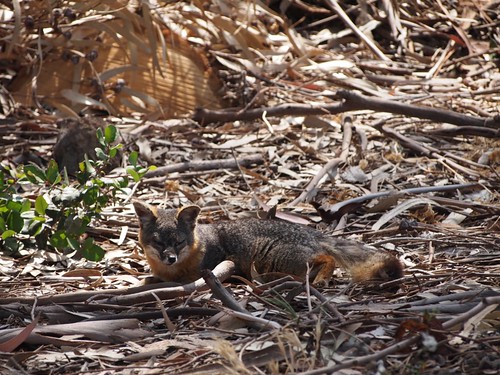On June 1, 2013, we joined the Friends of the Island Fox for a trip to Santa Cruz Island, part of Channel Islands National Park. After a 1.5 hour boat ride to Prisoner’s Harbor, we hiked about, inspected the newly restored wetlands, saw the Channel Island Scrub Jay, island specific flora and, of course, the Channel Island Fox, an endangered species that only lives on the Channel Islands of California.
About Island Fox from the Friends of the Island Fox web site…
“The island fox (Urocyon littoralis) is very small in size, comparable to a small domestic house cat. It is 15-18% smaller than its ancestor, and closest relative, the gray fox (Urocyon cineroargenteus). Island fox size: Adults typically 12-13 inches high at the shoulder, 23-27 inches long from nose to tail tip, weigh 3-6 lbs
Males are slightly larger than females. Coloration is similar to the gray fox: grizzled gray along the top of the head and back, but with a greater amount of rufous or cinnamon coloring along the belly, neck and legs, and white along the cheeks and throat to the chest. The tail also has a darker black stripe along the top.”
From Wikipedia.org…
“The island fox shares the Urocyon genus with the mainland gray fox, the species from which it is descended. Its small size is a result of insular dwarfism, a form of allopatric speciation. Because the island fox is geographically isolated, it has no immunity to parasites and diseases brought in from the mainland and is especially vulnerable to those the domestic dog may carry. In addition, predation by the golden eagle and human activities devastated fox numbers on several of the Channel Islands in the 1990s. Four island fox subspecies were federally protected as an endangered species in 2004, and efforts to rebuild fox populations and restore the ecosystems of the Channel Islands are being undertaken. Radio collars are being attached to foxes in an effort to track and locate the young foxes. To date these efforts have been largely successful.
There are six subspecies of the island fox,[1] each of which is native to a specific Channel Island, and which evolved there independently of the others. The subspecies are:[1]
- Urocyon littoralis littoralis of San Miguel Island,
- Urocyon littoralis santarosae of Santa Rosa Island,
- Urocyon littoralis santacruzae of Santa Cruz Island,
- Urocyon littoralis dickeyi of San Nicolas Island,
- Urocyon littoralis catalinae of Santa Catalina and,
- Urocyon littoralis clementae of San Clemente Island.
Foxes from each island are capable of interbreeding, but have genetic and phenotypic distinctions that make them unique; for example, the subspecies have differing numbers of tail vertebrae.
The small size of the island fox is an adaptation to the limited resources available in the island environment. The foxes are believed to have “rafted” to the northern islands between 10,400 and 16,000 years ago.[3] Initially, fox populations were located on the three northern islands, which were likely easier to access during the last ice age—when lowered sea levels united four of the northernmost islands into a single mega-island (Santa Rosae) and the distance between the islands and the mainland was reduced—it is likely that Native Americans brought the foxes to the southern islands of the archipelago, perhaps as pets or hunting dogs.[4]”
Links:
- Friends of the Island Fox – Web – Facebook – Twitter
- Channel Islands Park Foundation
- Channel Islands National Park
- Island Packers



